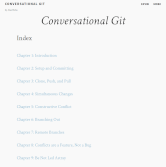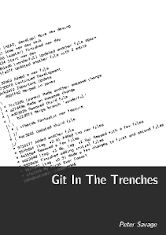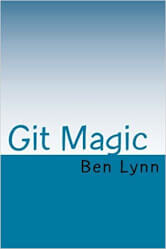Last Updated on April 27, 2023
4. Conversational Git by Alan Hohn
 The Conversational Git is a handy guide written in a verbose and breezy style. The author considers that a key goal is to be “conversational” – able to make basic small talk, even if not quite a native speaker.
The Conversational Git is a handy guide written in a verbose and breezy style. The author considers that a key goal is to be “conversational” – able to make basic small talk, even if not quite a native speaker.
The Conversational Git is well suited for a beginner to Git. It is a small, compact guide which is easy to read and follow.
Topics covered include:
- Setup and Committing – brief coverage of committing, staging, and removing files.
- Clone, Push, and Pull – multiple repositories, bare repositories, and cloning.
- Simultaneous Changes – teamwork, the failed push, merging in Git, and successful push.
- Constructive Conflict.
- Branching Out – looks at what branches are for.
- Remote Branches – pushing feature branches.
- Conflicts are a Feature, Not a Bug – feature branches with conflicts, and merging feature branches with conflicts.
- Be Not Led Astray – easy fixes when things go wrong.
- Serious Issues – the Git equivalent of surgery.
- Flow – tools and workflow.
5. Git In the Trenches by Peter Savage
 Git In The Trenches, or GITT is designed to be a book that focuses on teaching people to use Git by associating with scenarios that are experienced by a fictional company called Tamagoyaki Inc. Through reading about their day to day lives, the reader will learn not only how to use Git, but why version control systems are important and how to implement them within an organization.
Git In The Trenches, or GITT is designed to be a book that focuses on teaching people to use Git by associating with scenarios that are experienced by a fictional company called Tamagoyaki Inc. Through reading about their day to day lives, the reader will learn not only how to use Git, but why version control systems are important and how to implement them within an organization.
This book is not supposed to be purely a technical reference. Instead, GITT is more of a scenario based book and by reading it, it is hoped that the experiences and scenarios that you encounter will help give ways to apply Git in practical situations.
The book explores:
- Initializing a repo, adding files, removing files, committing, resetting.
- Logging, diffing, tagging, viewing historical data.
- Branching, merging, deleting branch, recovering branch, dealing with conflicts.
- GUI usage.
- Stashing, Cloning.
- Networking, Rebasing.
- Patching, Bisecting, Filterbranching, subtree, modules.
After Hours
- History of version control, svn, cvs, git.
- Simple Git internals, how commits are stored.
- In-depth look at diff and how tags are stored.
- Merging algorithms.
- Splitting up commits, line by line, hunk committing.
- Push and pull settings, reference discussion.
- Instaweb.
- Hooks.
6. Git Magic by Ben Lynn
 Git Magic is an open source guide to using Git, a version control system.
Git Magic is an open source guide to using Git, a version control system.
The book is well written, informative, and a good introduction to the world of Git.
This book has been translated into Chinese (Simplified), French, German, Italian, Korean, Polish, Portuguese (Brazilian), Russian, Spanish, Ukrainian, and Vietnamese.
Areas covered include:
- Basic Tricks – use these elementary examples to get your feet wet.
- Cloning Around.
- Branch Wizardy – instant branching and merging.
- Lessons of History – like cloning, branching, and merging, rewriting history is simply another power Git gives you.
- Multiplayer Git – looks at remote branches, multiple remotes and more.
- Git Grandmastery – some recipes.
- Secrets Revealed – takes a peek under the hood and explains how Git performs its miracles: Invisibility, Integrity, Intelligence, Indexing, Git’s Origins, The Object Database, Blobs, Trees, Commits.
This guide is released under the GNU General Public License version 3.
Next page: Page 3 – Git from the Bottom Up and more books
Pages in this article:
Page 1 – Pro Git and more books
Page 2 – Conversational Git and more books
Page 3 – Git from the Bottom Up and more books
Page 4 – Git Succinctly and more books
